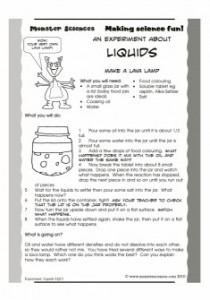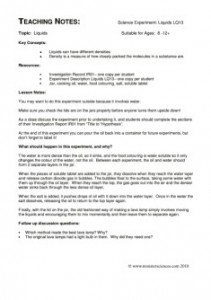An oldie but a goody, this lava lamp experiment uses several techniques for making the lamps, and teaches kids about liquid density and immiscible liquids – liquids that don’t mix.
 |
 |
An experiment about Liquids: Lava Lamp
What you will need:
- A small glass jar with a lid (baby food jars are ideal)
- Cooking oil
- Water
- Food colouring
- Soluble tablet eg aspirin, Alka-Seltzer
- Salt
What you will do:
1 Pour some oil into the jar until it is about 1/3 full.
2 Pour some water into the jar until the jar is almost full.
3 Add a few drops of food colouring. What happens? Does it mix with the oil and water the same way?
4 Now break the tablet into about 8 small pieces. Drop one piece into the jar and watch what happens. When the reaction has stopped, drop the next piece in and so on until you run out of pieces.
5 Wait for the liquids to settle then pour some salt into the jar. What happens now?
6 Put the lid onto the container, tight! Ask your teacher to check that the lid is on the jar properly.
7 Now turn the jar upside down and put it on a flat surface. Watch what happens.
8 When the liquids have settled again, shake the jar, then put it on a flat surface to see what happens.
What is going on?
Oil and water have different densities and do not dissolve into each other, so they would rather not mix. You have tried several different ways to make a lava lamp. Which one do you think works the best? Can you explain how they each work?
Teaching Notes: Monster Sciences Experiment: Liquids LQ13
Topic:
Liquids
Key Concepts:
Liquids can have different densities
Density is a measure of how closely packed the molecules in a substance are
Resources:
- Investigation Record IR01– one copy per student
- Experiment Description Liquids LQ13– one copy per student
- Jar, cooking oil, water, food colouring, salt, soluble tablet
Lesson Notes:
You may want to do this experiment outside because it involves water.
Make sure you check the lids are on the jars properly before anyone turns them upside down!
As a class discuss the experiment prior to undertaking it, and students should complete the sections of their Investigation Report IR01 from ”Title to “Hypothesis”.
At the end of this experiment you can pour the oil back into a container for future experiments, but don’t forget to label it!
What should happen in this experiment, and why?
The water is more dense than the oil, so it sinks, and the food colouring is water soluble so it only changes the colour of the water, not the oil. Between each experiment, the oil and water should form 2 separate layers in the jar.
When the pieces of soluble tablet are added to the jar, they dissolve when they reach the water layer and release carbon dioxide gas in bubbles. The bubbles float to the surface, taking some water with them up through the oil layer. When they reach the top, the gas goes out into the air and the denser water sinks back through the less dense oil layer.
When the salt is added, it pushes drops of oil with it down into the water layer. Once in the water the salt dissolves, releasing the oil to return to the top layer again.
Finally, with the lid on the jar, the old fashioned way of making a lava lamp simply involves moving the liquids and encouraging them to mix momentarily and then leave them to separate again.
Follow up discussion questions:
- Which method made the best lava lamp? Why?
- The original lava lamps had a light bulb in them. Why did they need one?



